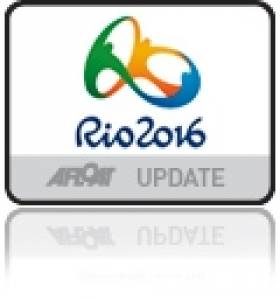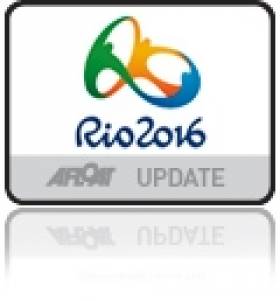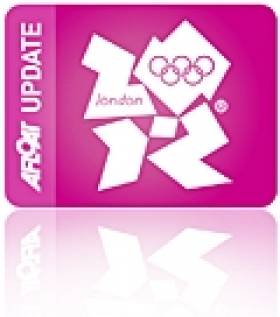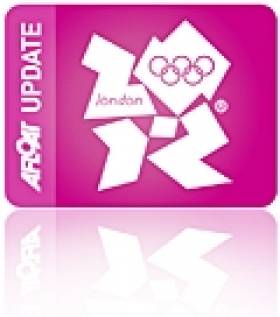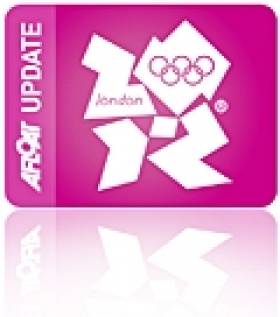Displaying items by tag: Annalise
#isafworldcup – A satisfying medal race finish is in store this morning at 11.45 for Annalise Murphy whose hard work paid off yesterday when she took a 9,1,5 to be fourth overall and four points off the Bronze medal position currently held by Britian's Alison Young.
The positions for this morning's live Medal Races have been decided following an intense day of competition at ISAF Sailing World Cup Weymouth and Portland yesterday.
After Friday only served up a race apiece for the Men's RS:X and 470, Saturday was always going to be a hard day with an additional race for each fleet added.
A 13-17 knot breeze coupled with a lumpy sea state tested the competitors with the leader boards fully shaped for the live Medal Races which will be available to view here from 11:00 local time
The Irish Sailing star will be hoping to move up one place and improve on her Olympic sailing Regatta result three years ago. Critically though, the forecasted breeze is only 8 knots from the north-west, potentially leaving Annalise without her heavy air boat speed advantage.
Marit Bouwmeester (NED) has been head and shoulders above her 35 other rivals in the Radial.
From seven races Bouwmeester counts five bullets and two seconds, an outstanding collection of results that has only been bettered by Great Britain's Helena Lucas (GBR) in the Paralympic 2.4mR event.
Bouwmeester was unlucky not to make it a clean sweep of race victories on the penultimate day of racing. She took the first race victory with a certain degree of comfort, finishing 19 seconds ahead of Anne Marie Rindom (DEN).
In the next race she took an early lead but relinquished the spot to Annalise who finished 19 seconds ahead. Bouwmeester led the third and final race of the day from the beginning but was passed by Evi Van Acker (BEL). Very little separated the pair as the race played out and the Belgian took the bullet by just seven seconds.
Annalise Drops To Seventh in Miami, Finn Lynch Makes Gold Fleet At First World Cup Regatta
#sailingworldcupmiami – Annalise Murphy sustained a drop of five places overall after a second result in the 30s took its toll on her overall score in Florida yesterday. The Dun Laoghaire Laser Radial sailor moves from second to seventh overall as Miami Olympic classes regatta enters the final day of racing this morning before tomorrrow's medal race finals.
Denmark's Anne-Marie Rindon had the lowest finishes of the top three Radial sailors today, but that didn't knock her off the top of the leaderboard. An 11-14 day means that she is now eating an 11th and discarding the 14th. Previously, a 7th was her discard. The day's results tightened things up, with second and third both in striking range.
It was a sun bathed day at ISAF Sailing World Cup Miami with the previous cool northern breeze from the replaced with a shifty, yet warmer, easterly that tested the sailors once again.
Evi Van Acker of Belgium is only five points back. Marit Bouwmeester is only two points behind that. This sets up some interesting running-math problems for the Medals Race on Saturday.
The hard-luck story of the day was Annalise Murphy, who was part of this conversation until she picked up a keeper 35th in race eight. "It was hard to know where you had to be," she said, and left it at that.
Meanwhile, in the mens Laser class, the National Yacht Club's Finn Lynch who leads Irish interest having made the Gold fleet at the first attempt has given an appraisal of his own debut performance in Miami: 'Super happy about making Gold fleet in my first World Cup! I found out today that it is a huuge step up from what I'm used to. Not so happy with my sailling today [53rd from 55] but hopefully tomorrow I can make up for it!
The young Dubliner leads Belfast's James Espey by two places with the two Irish Rio rivals currently placed 42nd and 44th respectively in the 55–boat gold fleet.
Britain's Nick Thompson, who says that his favorite boat is the foiling Moth, is doing nicely here in a Laser, in contact with the surface of the water. The former youth world champion leads the 106-boat fleet with an eight-point margin going into the final day of racing ahead of Saturday's double points Medal Race. In second place, Philipp Buhl of Germany has burned his throw-out race on a 34th, so he has more to lose than Thompson (a 12th to throw out) if the wheels fall off on Friday. Behind them are serious threats still within range, depending, and it remains a difficult racecourse.
Young Andy ("Pain is temporary; glory is forever") Maloney of New Zealand has had his moments of late. He won the Palma version of this event in 2013, and in 2012 was second at Hyeres. As race day five beckons, he is seventh in the standings and found Thursday's conditions not quite as challenging as the races on Wednesday. "They moved the Thursday start into the morning," he said. "By comparison it seems to get a lot more patchy in the afternoon, as things heat up."
The second race of the day was ripe to be abandoned, and it was. "Between races, we were seeing 40 degree shifts with pressure drops to 5 knots," Maloney said, "and then pressure building to 15 knots and back to 5. They got a start off, and a massive lefty came down with heaps of pressure. It was a lay to the weather mark, so that race was abandoned, and we waited around for a bit. I think they were hoping it would stabilize, but finally they set up at an average angle and got on with it. There were lots of little shifts, but the thing was to be sure you were in phase with the big ones. When it's that tricky, nobody can get everything right."
Maloney won a race on Monday. Today he went 7-11.
Annalise Struggling in Fickle French Winds
#HyeresSWC – There was no significant improvement for Irish sailing star Annalise Murphy who is uncharacteristically placed in a lowly 43rd place at the ISAF World Cup in Hyeres, France this afternoon.
A black flag disqualification in race four has ruled the Dun Laoghaire sailor out of the running after five races in her 55-boat fleet.
'In silver fleet now so going to use it to work on my racing' Annalise told fans.
Meanwhile Belfast lough sailor James Espey is now in 18th place from a 113 in the mens Laser class after falling back from joint second after the opening rounds on Monday.
Two days of fickle breeze at Hyères brought the Qualification Series to a close as the world's best sailors positioned themselves at the top ahead of three days of Final Series racing.
In a breeze that stabilised later on in the day, peaking at 10 knots, Ivan Pastor (ESP) and Charline Picon (FRA) were the star performers in the Men's and Women's RS:X on the second day of racing in Hyères to take a clean score through to the Final Series.
Pastor has been a man on fire recently epitomised by back-to-back ISAF Sailing World Cup victories in Miami and Palma which moved him to World #1 in the Men's RS:X World Rankings. He was at his best again in Hyères winning both of the day's Men's RS:X races to take the overall lead and was pleased with the way things went, "I didn't have good starts but I chose the right side of the course," the Spaniard said. "I had good speed and good pumping to win both races. It was great for me. It was a difficult day for the RS:X with a lot of pumping and shifty winds but it was okay for me."
The Spaniard finishes the qualifying series ahead of Julien Bontemps (FRA) and Piotr Myszka (POL) to carry forward a clean slate into the start of Wednesday's Final Series and Pastor isn't getting carried away with his performance on the second day, "I want to compete day per day, it's a long race with this system and you've never won anything until the end."
Finding form in the Women's RS:X was French sailor Picon who, after London 2012, is competing at her second event following a fifth at the RS:X Worlds in Buzios, Brazil. Using her light weight to her advantage Picon attacked the light breeze head on, "I won the first and the second race of the day and I am very happy because my coach wanted me to win in these conditions because they are good for me. It's like the conditions in Rio and I have to be the leader in these winds."
Things didn't go all her way in the third race of the day as she explained, "I wasn't happy for the last race because I made a mistake on the upwind on the first run and went down to between 25-30. It was hard to get to the head of the race and I finished tenth so not too bad. I am first after the qualifying series which is nice but tomorrow is another day and it will be windy."
Spain's Blanca Manchon (ESP) took the final race win of the day to move to third whilst Bryony Shaw carries forward a second place to the Final Series after a steady day of racing.
Two race wins catapulted Luke Patience and Joe Glanfield (GBR) to the top of the Men's 470 fleet to move them nicely into the Final Series. They dislodged overnight leaders Paul Snow-Hansen and Dan Wilcox (NZL) who were still upbeat, "We had the best day we could have had," said Wilcox. "We struggled a little bit off the line and on the first beats but we had some good comebacks."
Like the Brits, the Kiwis are a new partnership and Snow-Hansen is happy with consistent results top five results over the Qualifying Series that sees them advance to the finals second overall, "If we can keep up there then we're really stoked. We're a new combination so we haven't sailed much together so we don't know what our weaknesses are. We've got to keep getting better throughout the week and it'll be hard to stay at the front."
Fernanda Oliveira and Ana Barbachan (BRA) were on form once again in the Women's 470 to pick up their third race win of the week. They advance to the final series on top followed by Lara Vadlau and Jolanta Ogar (AUT) and Tina Mrak and Veronika Macarol (SLO).
Dutch and French sailors remain at the forefront of the Nacra 17 fleet having dominated the proceedings at ISAF Sailing World Cup Palma. Elke Delnooz and Coen de Koning (NED) top the leader board followed by Franck Cammas and Sophie de Turckheim (FRA) who are making their inaugural appearance in the class. ISAF Sailing World Cup Palma runners-up Renee Groeneveld and Karel Begemann (NED) are third.
Tonci Stipanovic (CRO) enjoyed another strong day in the Laser to remain at the top of the 113-boat fleet. Following the Croatian is Bruno Fontes (BRA), Sam Meech (NZL), Jesus Rogel Sanchez (ESP) and Mattis Naud (FRA).
In the Laser Radial Finland's Tuula Tenkanen was a model of consistency and across three races recorded a first, second and third. Her standout performance pushed her to the top of the Radial leader board ahead of Mathilde de Kerangat (FRA) and Marit Bouwmeester (NED).
Taking the victories in the Finn on the second day was Oliver Tweddell (AUS), Vasilij Zbogar (SLO) and Andrew Mills (GBR). The Slovenian was the most consistent sailor in the fleet adding a sixth and a third to his tally to move up to top spot. Mills and Tweddell were less impressive than Zbogar but sit seventh and eighth respectively. Rounding off the top three ahead of the final series is Giles Scott (GBR) and Pieter-Jan Postma (NED).
Germany's Victoria Jurczok and Anika Lorenz maintained their solid start in the 49erFX and solidified top spot after the second day of racing. Following them is Charlotte Dobson and Mary Rook (GBR) and Alex Maloney and Molly Meech (GBR).
The 49er fleet were the last off the water at 20:10. Holding the lead is Federico and Arturo Alonso (ESP) followed by Pavle Kostov and Petar Cupac (CRO) who have finished third in all six races to sit second overall. Overnight leaders Dylan Fletcher and Alain Sign (GBR) slip to third.
In the 2.4mR Heiko Kroger (GER) holds a one point advantage over London 2012 Paralympic gold medallist Helena Lucas (GBR) and Bruno Jourdren, Eric Flageul and Nicolas Vimont-Vicary (FRA) lead the Sonar.
With the Qualification Series over, sailors now carry forward a non discardable race with their points equal to their final rank in the qualification stage. A three day final series now ensues ahead of Saturday's Medal and Stadium Races.
Racing resumes at 11:00 local time on Wednesday.
Espey Reigns Supreme as Irish Laser Class Champion
#laser – The VonZipper Laser National Championships under International Race Officer Con Murphy concluded on Dublin Bay yesterday with two final races in a stiff SE'ly sea breeze. In the Standard (Full) rig class, Irish London Olympic Men's Single handed representative James Espey of Ballyholme YC narrowly beat Annalise Murphy of the host club who, sailing the full rig for the first time, had a great event with four race wins and three seconds.
The two London Olympians sailed neck in neck up to the final race and gave the spectators and fellow sailors a great display of superb competition. Mattie O'Dowd of the RSGYC finished in third place with Chris Penny of East Antrim in fourth and Cork's Nick Walsh the first Master.
In the Radial class, the battle of the 'Darraghs' from Cork saw Darragh O'Sullivan from Kinsale take the title ahead of Baltimores Darragh Mc Cormack. Dan O'Beirne of the RSGYC took third and Suzanne Flanigan of Ballyholme took the Ladies Championship.
Mark Hassett of Schull SC comfortably won the 4.7 Championships with a 17 point lead over second place Richard Maher from Perth, Australia. 6 points behind in third was Conor O Beirne from the RSGYC followed by the first girl in the fleet Sorcha Ni Shuilleabhain from Kinsale.
The championships, sponsored by Dalkey Optician Paul Gill, was deemed a great success with excellent racing conditions and the Parade of Tall ships and fleet of spectator boats giving a fantastic backdrop on the final day. Full results below.
#laser – London Olympian Annalise Murphy who scored Ireland's top Olympic sailing result for 32 years earlier this month in Weymouth made a welcome return to her home waters of Dublin Bay yesterday to compete in the first race of the Irish Laser National Championships hosted by her home club the National Yacht Club. Scroll down for the first day's action captured by photographer Aidan Tarbett.
Annalise Leads But Van Acker Closes the Gauge
#annalisemurphy – Annalise Murphy remains at the top of the Laser Radial fleet at the Olympic Games tonight but her unbeaten run came to an abrupt halt when strong winds forecast for Weymouth bay failed to materialise.
Instead the 22-year old debutante faced with a new course, new wind direction and placed 8th and 19th today.
With five fleet races left to sail Annalise is on 12 points, Evi Van Acker BEL is next on 14 points and Marit Boumeester NED on 19 and Alyson Young GBR on 23.
Racing was tricky today for most fleets with postponements and recalls. Race 5 for the Laser Radials had to be abandoned and rescheduled for 20 minutes later. Annalise Murphy got off to a good start towards the top of the fleet and rounded the first mark in 8th place. Her position fluctuated slightly throughout the race but ultimately she finished in 8th place while Van Acker (BEL) took first and Young (GBR) took second.
"It was light in areas and strong in other areas on the [race] course and I tried to stay as much as I can in the stronger wind" she told RTE news last night.
Race 6 saw Murphy get off to a great start at the top of the pack but she chose, along with many others, to take the left side of the course. Her rivals veered to the right which, within moments, was clear to be the correct choice and very quickly gained a 50 meter lead. Murphy then had the difficult task of making her way back across the fleet. It cost her 150 meters and left her in 22nd rounding the first mark. She fought hard throughout the rest of the race but just couldn't make up the distance and finished in 19th.
The discard came in to play today for the Radials after the fifth race. This means that Murphy can discard her 19th which still leaves her 1st overall on 12 points. In 2nd place is Evi Van Acker (BEL) on 14 points with Marit Bouwmeester (NED) in 3rd on 19 points. Tomorrow will be a rest day for the fleet. They will sail a further four fleet races on Friday and Saturday with the medal race taking place on Monday, 6th August.
Ryan Seaton and Matt McGovern had a similarly challenging day in the 49er class. They rounded the first mark of Race 5 in 15th place but thanks to some tactical sailing they overtook three of their competitors to finish the race in 12th. Unfortunately Race 6 proved to be their most difficult to date and they finished towards the back of the fleet in 19th. The 49er discard also came in to play today so the pair discount the 19th and now sit 9th overall on the leader board on 41 points. The leaders Outteridge & Jensen (AUS) are on 10 points followed by Burling & Tuke (NZL) on 23 points and Dyen & Christidis (FRA) on 30 points. The 49er class will continue to race tomorrow and still have a further nine races to sail before the medal race.
James Espey also had his third day of racing today in the Laser class. The Laser fleet also had to contend with undoubtedly frustrating postponements and recalls. Espey finished 47th in Race 5 and an improved 42nd in race 6. With his discard he lies 45th overall. The Laser class will also have a rest day tomorrow with racing resuming on Friday.
Today was the rest day for Peter O'Leary and David Burrows and the Star class. The Irish pair remain in 9th overall and resume racing tomorrow.
Racing will continue tomorrow for the Star and 49er. Ger Owens and Scott Flanigan will also make their debut in the 470 class. The Laser Radial and Laser are on a rest day. Sailing action starts at 12 noon in Weymouth.
#sailforgold – Annalise Murphy takes a bronze medal back to Dun Laoghaire tonight after winning the Laser Radial medal race at the Sail for Gold regatta in Weymouth today. The 22-year old Dubliner has repeated last year's performance in Weymouth to take bronze for the second year running at the Olympic venue event.
Today's final medal race win brought her from fifth to third overall, beating world champion Marit Bouwmeester of Holland in to the bargain.
Ireland stands to add to its tally later today with Skiff sailors Ryan Seaton and Matt McGovern will be next to sail in the 49er medal race this afternoon. Peter O'Leary and David Burrows, currently in third place in the Star class, will also be hoping for a podium place.
More results as we have them.
Annalise Ends Radial Worlds in 25th Place
#LASER RADIAL – London Olympic debutante Annalise Murphy (22) has finished the week at the Laser Radial World Championships in Germany with a 33rd and a 55th to dropping nine places on the final day to leave her 25th overall in the 133-boat fleet.
After a collision in the opening stages of the regatta it was a tough week for Annalise who also showed her world beating potential taking two wins and two seconds when the breeze was up on the Woehlenberger wiek . Last night Team manager James O'Callaghan said Annaslise has 'plenty of work to do' between now and the Olympics.
Racing was postponed at Boltenhagen for three hours as there was barely any wind but later a sea breeze came in and there were six to eight knots for the first race and ten to twelve knots for the second.
Overall results available for download below as a pdf document.
Afloat's Irish Olympic sailing team news
Annalise 16th at Laser Radial Worlds in Germany
#LASER RADIAL WORLDS – Annalise Murphy's 64th and 33rd scored yesterday in the penultimate day of racing at the Laser Radial World Championships in Germany put her 16th overall with overall scores tighenting significantly at the top of the table.
This season's most consistent sailor, with three World Cup wins under her belt Lijia Xu (CHN) had her worst day of this Boltenhagen regatta with light winds saddling her with a 14th and 12th, these are now her two discards.
However Xu is still ahead of Gintare Scheidt (LTU) in the overall results due to her 12–point lead with which she went into today's races.
The final rounds will be sailed today and there is no medal race in this world championship format.
Yesterday's first start at the Audi Laser World Championship 2012 was postponed for three hours as there was barely any wind. Around 1pm a sea breeze came in and there were six to eight knots for the first race and ten to twelve knots for the second. A small current on the Wohlenberger Wiek kept the sailors in line and there was neither a general recall nor a single early starter during any of the starts.
Although for Lijia Xu (CHN) the racing did not go as smoothly as on previous days she is still ahead of Gintare Scheidt (LTU) in the overall results due to her 12 point lead with which she went into today's races. Scheidt convinced in the first race where she was second but had to discard the sixteenth place from the second race as her worst result in the final series so far. With the second discard after ten races Alison Young (GBR) only adds one point to her overall score and moves back up into third place.
Sari Multala (FIN) slips to fourth place but with only eleven points separating her and Lijia Xu in first place there is still the possibility for some major changes in the overall rankings. Defending World Champion Marit Bouwmeester (NED) is keeping steady in fifth place overall with two ninth places. 18-year-old newcomer Erika Reineke (USA) scored spectacular results in gold fleet today, achieving a third and a first place ahead of fellow countrywoman Paige Railey who finished 20th and ninth.
Reineke is still ahead in the U21 rankings as well, having established a 69 point lead on Brenda Bowskill (CAN) in second place. Michelle Broekhuizen (NED) is in third place.
#LASER RADIAL – Discarding her first race result of 65 keeps Ireland's Annalise Murphy in 15th overall at the Laser Radial worlds in Boltenhagen Germany tonight but a gap of 13 points exists to tenth overall so a place in Sunday's coveted medal race depends on achieving the same results as shed did on Tuesday and Wednesday.
Results available for download as a pdf below.
As the temperatures have been creeping up slowly the wind has calmed down slightly in Boltenhagen, where the first races of the women's Radial final series of the Audi Laser World Championship 2012 are taking place. The famously shifty winds between eight and sixteen knots made for tactically demanding conditions on the water today. "Speed is not the top priority in these conditions", says Principal Race Director Klaus Lahme, "tactically it is more important to catch the right wind shifts."
"I think being consistent is the most important thing for an all-round sailor", adds Lija Xu (CHN) after winning the first gold fleet race and coming in second later in the afternoon. She swops places at the top of the leader board with Sari Multala (FIN) who had an off day with a tenth and a 25th place, her worst results of the entire series so far. Gintare Scheidt from Lithuania pushes from fifth into third place.
Marit Bouwmeester (NED) also improves, she is up from seventh to fifth place in the overall ranking even though the day did not go particularly smoothly for her. She was fifth in the first race and because of her consistent results in the first seven races she was able to discard the 22nd place from today's second race. Sara Winther (NZL) seemed overly eager at the starting line and received two of the 21 black flag disqualifications awarded today. She drops from 13th to 32nd place overall. Paige Railey (USA) continues to deliver steady results and currently places ninth overall. In the gold fleet's second race Anna Weinzieher from Poland managed a fairly unexpected win ahead of Lija Xu and Sophie de Turckheim (FRA).
In the U21 results it is looking good for Erika Reineke from the USA who is able to maintain her lead. Michelle Broekhuizen (NED) claims the second place while Marie Bolou from France drops to third.


























